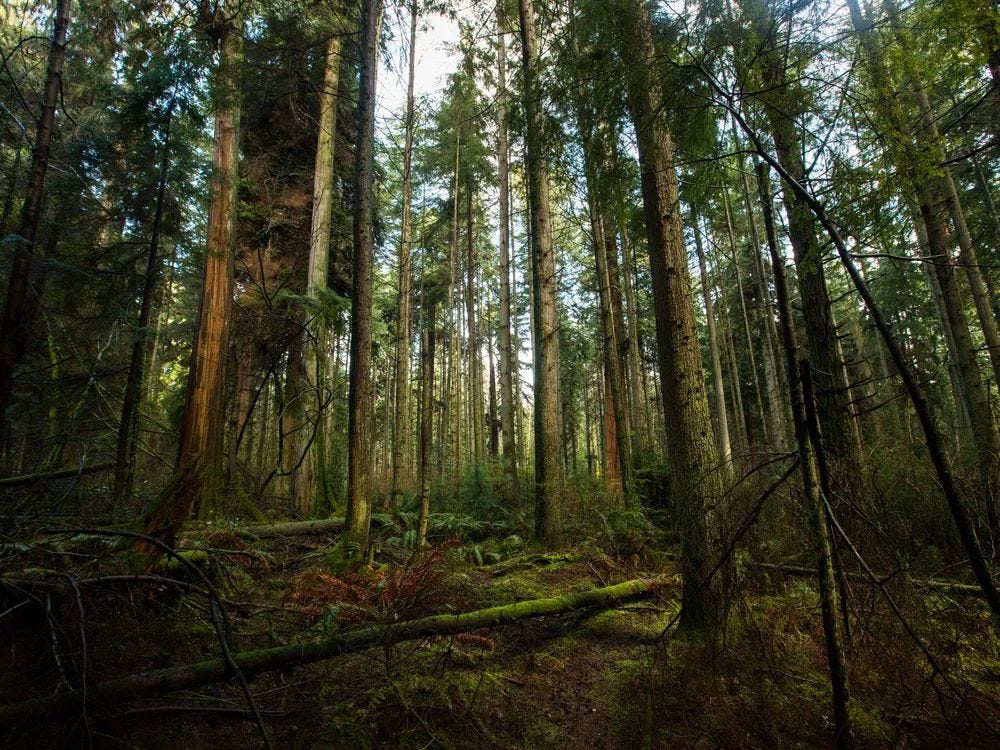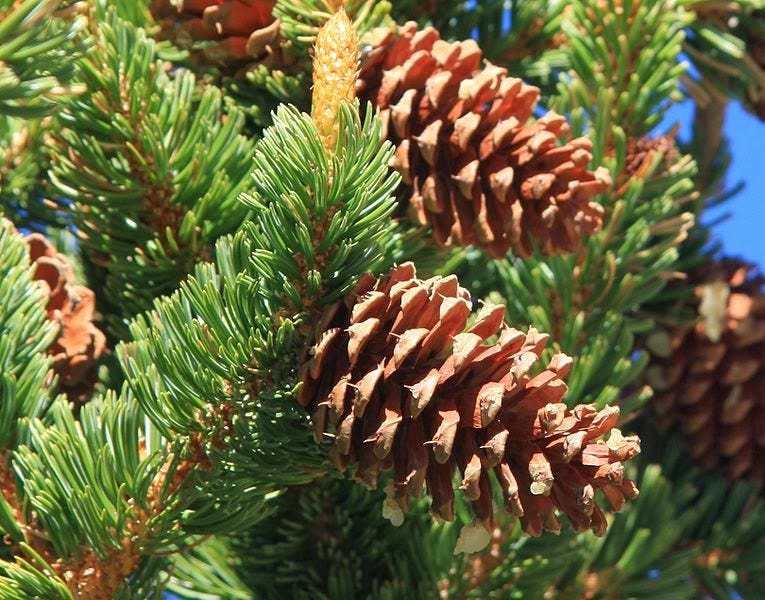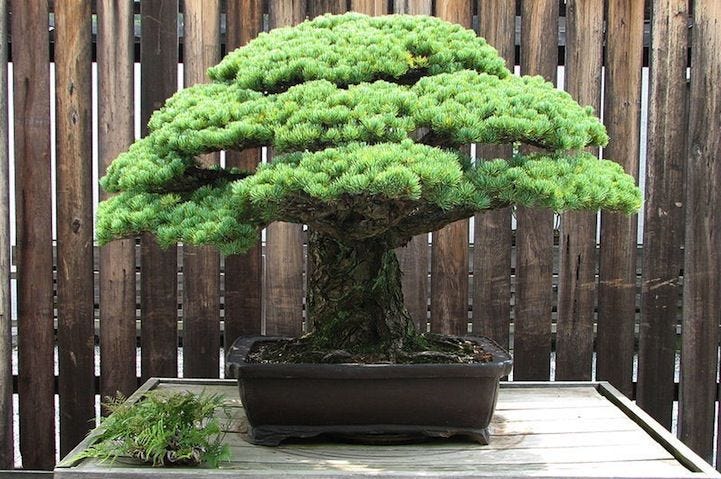Can Pine Trees Save Our Planet?
Resilient Giants of the Earth--Guardians of Climate, Beauty, and Balance
My First Teacher
A stone’s throw from my house stood a white pine that, to my ten-year-old eyes, seemed to stretch endlessly upward. This tree was my refuge from a household with four brothers who competed over everything, wrestled, and scrambled for attention. My pine tree’s cantilevered branches provided a sanctuary where I could climb, listen to the needles’ sigh, and find a moment of peace.
One day, I decided to climb higher than ever before. As I reached the highest branch I dared, the wind began to howl, and the tree swayed with startling force, bending and bowing. Climbing down wasn’t an option—I needed the trunk’s support to stay steady. Instead, I perched on a sturdy branch, wrapping my legs tightly around the tree, holding on as the wind intensified. Despite the wild motion of the branches above, I could feel the tree’s deep-rooted strength. Its base remained still. I felt its rootedness.
I learned the secret of the pine tree that day: it’s a living thing, connected to the earth and offering itself to the small ecosystem of my backyard for its benefit.
That white pine was my first teacher in the lessons of balance, strength, and resilience, and laid the foundation for my understanding of the role pine trees play in supporting and anchoring our ecosystems.
An Anchor for Our Ecosystems
Pine trees (genus Pinus) are nature’s quiet heroes, performing critical ecological roles. They absorb significant amounts of carbon dioxide (CO₂), combat soil erosion, provide habitats for countless creatures, and improve air and water quality. Unlike deciduous trees, pines retain their needles year-round, allowing them to photosynthesize continuously, even in winter. Their needle-shaped leaves and waxy coating enable them to thrive in harsh conditions, such as arid deserts or frigid mountain slopes.
In addition to stabilizing ecosystems, pines act as natural air purifiers. Their capacity to filter pollutants and stabilize watersheds makes them essential for healthier environments. Remarkably, mature pine trees can absorb up to 22 pounds of CO₂ annually. Larger species, like the Ponderosa Pine and Eastern White Pine, sequester even more. Pine forests in boreal and temperate zones serve as significant carbon sinks, storing approximately 30% of the world’s forest carbon. Pine trees are mighty warriors in
Inspiring Us Through the Ages
Pine trees’ value extends beyond their ecological contributions; they hold a revered place in art, literature, and spirituality. In Isaiah 41:19, God promises to transform the desert into a lush grove:
I will put in the wilderness the cedar, the acacia, the myrtle, and the olive; I will set in the desert the cypress, the plane, and the pine together.
This promise became a literal reality in 1948 when Israel became a nation and began reforesting its deserts, planting over 240 million trees, including pines, to restore the lands.
Even their sound inspires wonder. The Greek term psithurism describes the gentle whisper of wind through pine needles. Liu Chi, a 14th-century Chinese scholar, eloquently described this phenomenon:
Among plants and trees, nothing is better suited to wind than the pine. Listening to it can relieve anxiety, expand the spirit, and lighten the heart.
Resilience: The Hiroshima Pine
One of the most poignant examples of a pine tree’s resilience is the story of the Hiroshima bonsai. This Japanese black pine, cultivated for over 390 years, survived the atomic bombing of Hiroshima in 1945. Despite being just 1.5 miles from the epicenter, it endured the blast’s intense heat and radiation. Over time, the tree sprouted new growth, symbolizing hope amid devastation. Today, it thrives at the National Arboretum in Washington, D.C., as a living monument to peace and renewal.
The story of the Hiroshima bonsai reminds me of climbing the towering pine trees in our backyard. While the Hiroshima bonsai is tiny in comparison to that giant, its resilience mirrors the steadfast nature of all pine trees.
Let’s teach our children that pine trees everywhere quietly sustain life, purify our air, and combat climate change. Here is an easy lesson to teach this concept:
Lesson: Learn How Pine Trees Fight Climate Change
A Lesson for Parents, Grandparents and Teachers.
Retell what you read in the article above and then invite children to discover how much CO2 the pine tree you find is replenishing the natural world.
What is CO₂?
CO₂, or carbon dioxide, is a gas released by people breathing, cars, and factories. It’s natural and necessary in small amounts, but too much of it traps heat in the atmosphere, causing climate change. Trees, including pine trees, absorb CO₂ and help clean the air, making them essential for keeping our planet healthy and balanced.
How Trees Absorb CO₂ and Release Oxygen
Pine trees “breathe in” CO₂ and “breathe out” oxygen using a process called photosynthesis. Their green needles use sunlight, water, and CO₂ to make energy for the tree. As a result, they release oxygen as a byproduct, which is essential for humans and animals to breathe. Pine trees are like natural air filters that make our environment cleaner and healthier.
Measuring a Pine Tree
Head outside and find a pine tree to study. Use a measuring tape or string to measure around the tree trunk at chest height; this is called the tree’s circumference. Once you have the circumference, divide it by 3.14 (π) to find the diameter. For example, if the circumference is 31.4 inches, the diameter is 10 inches. This tree would absorb about 48 pounds (22 kilograms) of CO₂ each year. Explain to students that bigger trees absorb even more CO₂, making them even more valuable in fighting climate change.
Why It Matters
Trees are natural air cleaners. They remove harmful CO₂ from the air, store it, and release oxygen for us to breathe. Without enough trees, there would be too much CO₂ in the atmosphere, causing the planet to warm faster. Taking care of trees and planting more is one of the simplest and most powerful ways to protect our environment and combat climate change.
Wrap-Up Activity:
To reinforce the lesson, have students draw a picture of a tree showing how it “breathes in” CO₂ and “breathes out” oxygen. End with a discussion question: Why should we take care of trees and plant more of them? Encourage answers like, “They clean the air, give us oxygen, and help fight climate change.
My New Book Is Live! 🌿
I'm pleased to announce the release of Nature Study Companion: Simple Ways to Explore Wonders Near and Far!
This guide is designed to inspire families to reconnect with the natural world through simple, meaningful activities. Whether exploring your backyard or venturing to meadows and woods, this book is your perfect companion for discovering the beauty and wonder of God’s creation.
Become an Early Reviewer! 🎉
I’m inviting YOU to be one of the first to review this new release! Early reviewers will receive a FREE e-copy of the book in exchange for an honest review on Amazon.
📌 Here’s How to Join:
Simply sign up using this quick form:
👉 https://form.jotform.com/250115646452149
Your feedback means the world to me, and your review will help others discover the joy of nature study. Thank you for your support in bringing this book to life! 🌿
With deep gratitude,
Sheila Carroll
Living Books Press



